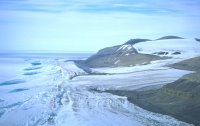 Ancient water bodies may contain ecosystems adapted to life beneath more than two miles of ice.
Ancient water bodies may contain ecosystems adapted to life beneath more than two miles of ice.The Earth Institute at Columbia University - Lying beneath more than two miles of Antarctic ice, Lake Vostok may be the best-known and largest subglacial lake in the world, but it is not alone down there. Scientists have identified more than 145 other lakes trapped under the ice. Until now, however, none have approached Vostok’s size or depth.
In the February 2006 issue of Geophysical Review Letters, scientists from the Lamont-Doherty Earth Observatory, a member of The Earth Institute at Columbia University, describe for the first time the size, depth and origin of Vostok’s two largest neighbors. The two ice-bound lakes are referred to as 90ºE and Sovetskaya for the longitude of one and the Russian research station coincidentally built above the other. The scientists’ findings also indicate that, as suspected with Lake Vostok, an exotic ecosystem may still be thriving in the icy waters 35 million years after being sealed off from the surface.
The lake depths, estimated to be at least 900 meters, were calculated from gravity data taken during aerial surveys in 2000 and 2001. Because gravitational force is directly related to mass, a decrease in gravitational pull over the ice sheet corresponds to a decrease in mass beneath the ice. “Over the lakes, the pull of gravity is much weaker, so we know there must be a big hole down there,” said Bell.
Their depth, along with the fact that they are parallel to each other and Lake Vostok, indicate that the lake system is tectonic in origin, the authors conclude.
This, along with the tectonic origin of the lakes, supports the idea that despite climate changes on the surface over the last 10 million to 35 million years, the volume of the lakes have remained remarkably constant, providing a stable, if inhospitable, environment that may harbor an ancient and alien ecosystem adapted to life beneath the ice sheet. However, just how, when or even whether scientists will risk the possibility of contaminating the lakes to confirm their suspicions remains the subject of an ongoing international debate.
The study was supported by the Lamont-Doherty Earth Observatory, the Palisades Geophysical Institute, NASA, and the National Science Foundation.
Related Entries : Melting of permafrost threatens homes and roads.
World is at its 'hottest' since prehistory.
Global warming may be shrinking Alaska’s lakes.